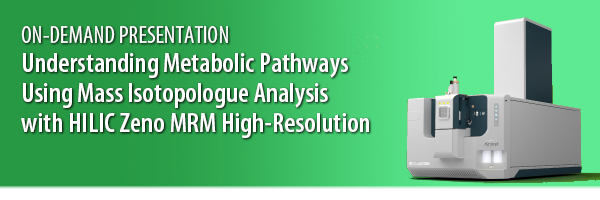Join us for this on-demand presentation and discover a method that can be used for performing structurally-resolved mass isotopologue distribution analysis of metabolites.

Format: On-demand
Duration: 40 minutes

Accurate reconstruction of metabolic pathways is an important prerequisite for interpreting metabolomics changes and understanding the diverse biological processes in disease models. A tracer-based metabolomics strategy utilizes stable isotope labeled precursors to resolve complex pathways by tracing the labeled atom(s) to downstream metabolites through enzymatic reactions. Isotope enrichment analysis is informative and achieved by counting total labeled atoms and acquiring the mass isotopologue distribution (MID) of the intact metabolite. However, quantitative analysis of labeled metabolite substructures/moieties can offer more valuable insights into the reaction connections through measuring metabolite transformation.
In this presentation, you will see how we developed a method that couples hydrophilic interaction liquid chromatography (HILIC) with Zeno trap-enabled high-resolution multiple reaction monitoring (MRMHR) in order to acquire the isotopic labeling information at the intact metabolite and moiety level simultaneously.
We show the method performance of HILIC-Zeno MRMHR compared to that of the HILIC-SWATH and HILIC-general MRMHR with regards to the aspects of sensitivity, accuracy, and fragmentation reproducibility in MID analysis based on the measurement of 13C or 15N-labeled cellular samples.
Further method application is demonstrated using a classic neuronal model of rotenone-induced neurodegeneration and reveals diverse flux regulations via glucose and glutamine metabolism into glutathione metabolism related to neurodegeneration.
By watching this presentation you will learn about ...
- utilizing the HILIC-Zeno MRMHR method for performing structurally-resolved mass isotopologue distribution analysis of metabolites
- tracing the labeled 13C/15N atoms in the moieties of metabolite isotopologues to reconstruct the cell-type and condition-specific pathways of glutathione metabolism
- quantitative isotopologue analysis to elucidate glutathione metabolism regulation at both metabolite and enzyme level
If you have a colleague who may also be interested in the subject of this webinar, please recommend it to them by using the link below.

The Presenter
 Luojiao Huang
Luojiao Huang
Metabolomics and Analytics Centre, Leiden Academic Centre for Drug Research, Leiden University, Leiden
Luojiao Huang studied traditional Chinese pharmacy at China Pharmaceutical University, and obtained her BSc degree with honors in 2015. In 2018, she started her PhD work at Leiden University and during her research has developed a comprehensive analytical strategy for characterizing the metabolic activity related to PD neurodegeneration, tackling the current analytical challenges faced in selecting an appropriate polar stationary phase used in polar metabolome analysis, advancing the analytical method for tracer-based metabolome analysis, and developing a computational workflow for metabolic flux analysis.
Sponsor:




